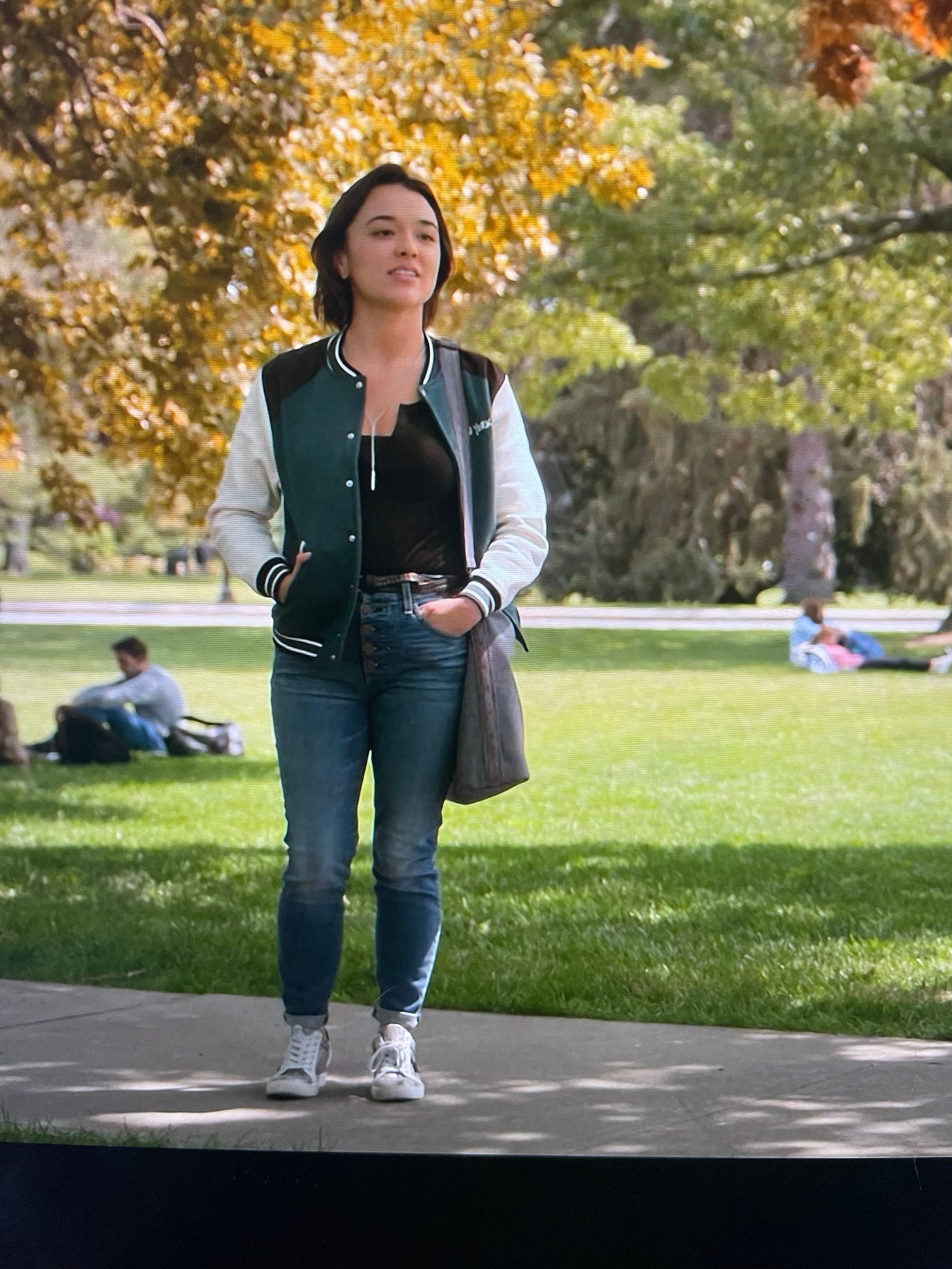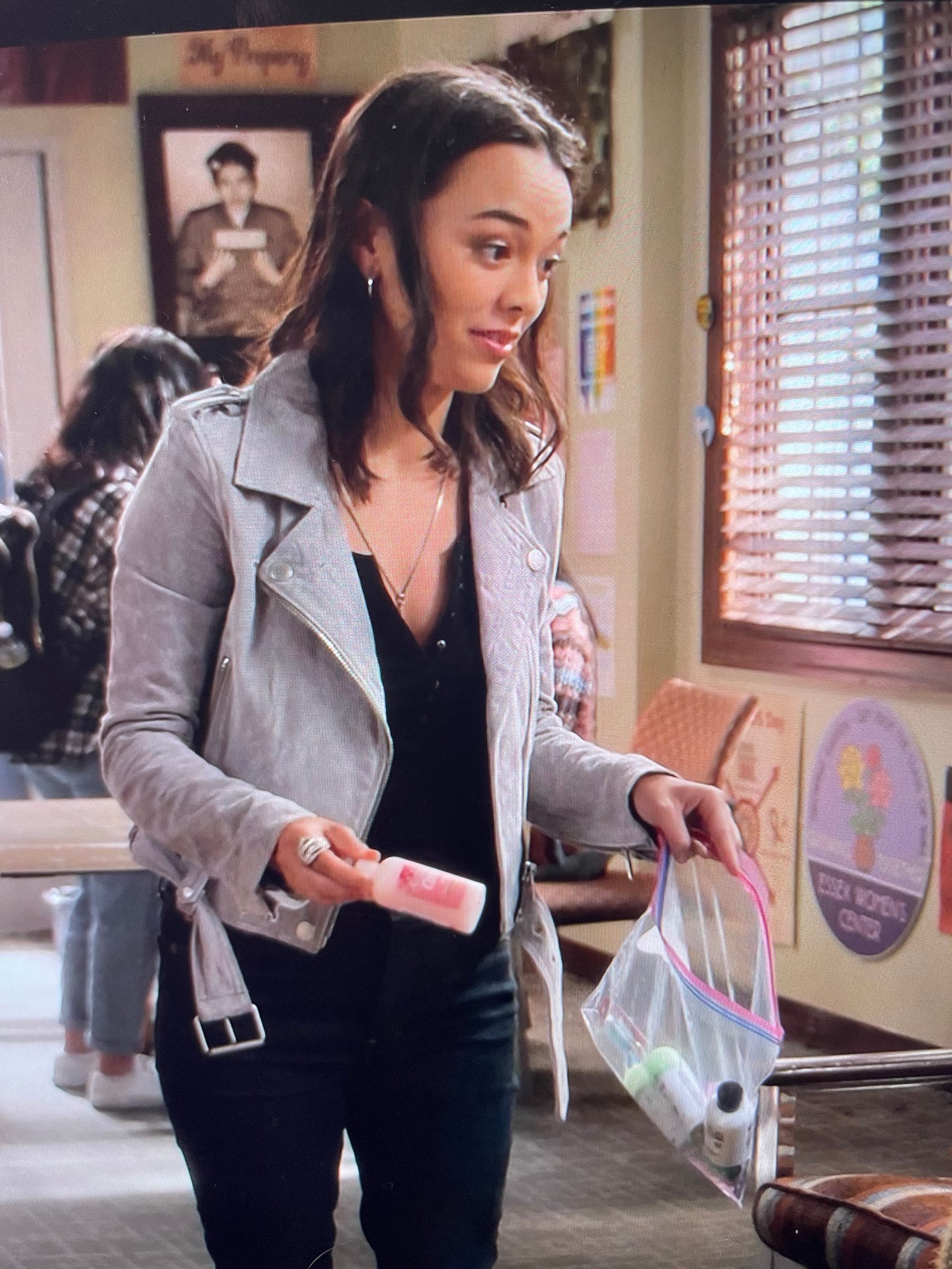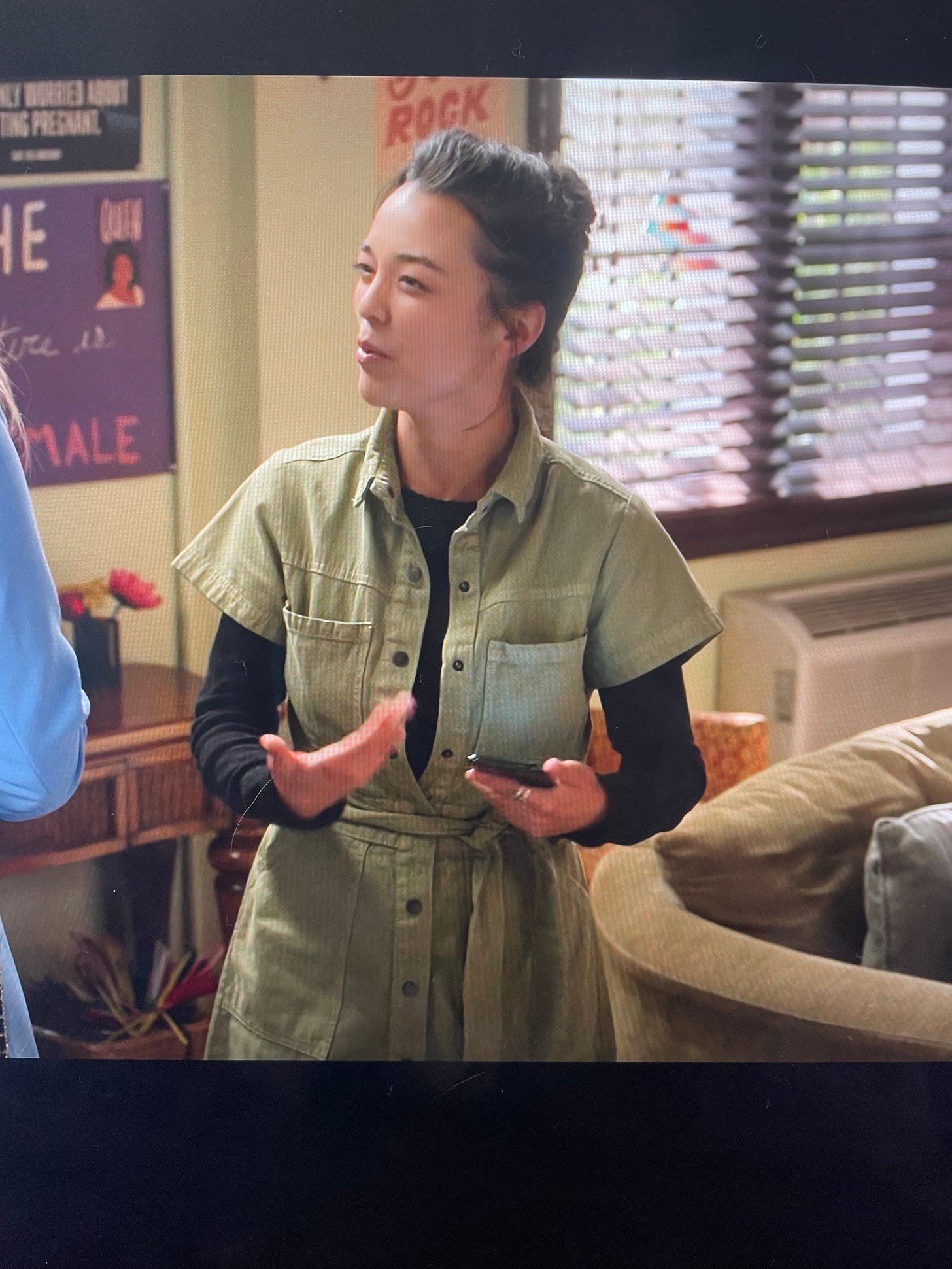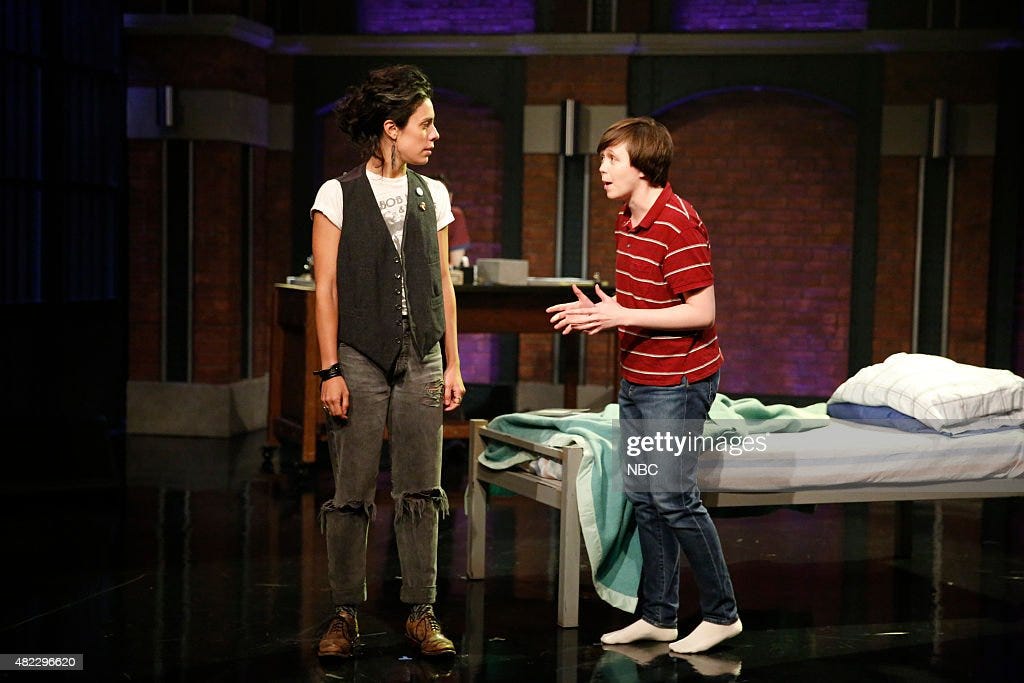A few months ago, I went mini-viral on TikTok. It was exciting, but terrifying. In the video, I shared my frustration with the styling (or, change in styling) of the character Alicia (played by Midori Francis) in The Sex Lives of College Girls, a very buzzy HBO Max show created by Mindy Kaling. Sex Lives dropped season two at the end of 2022, with varying degrees of excitement and criticism. Personally, I was most disappointed by the femme-ification of Alicia, a recurring character and queer love-interest from Season 1.
Alicia first came to us as a soft butch cutie, and, of course, the head of the campus Women’s Center. She wore flannel, chinos, little punky necklaces, and Calvin Klein sport’s bras. We saw Alicia in boxy leather jackets and a Brandi Carlisle-esque messy bob. In short, she looked like the kind of soft masc cutie you’d see ordering a $3 margarita at Cubbyhole. She’s the kind of girl who wryly shakes her head at her love interest, Leighton, who can drop hundreds of dollars without blinking, and passionately defends the many-gendered weirdos in her care. When I first saw Alicia, I was so thrilled to fan girl over someone I realistically would have been pretty obsessed with in college. This rarely happens for me in my TV viewing experiences.
Much to my dismay, in this most recent season, Alicia returns in skinny jeans, tailored moto-jackets, lower-cut shirts with cleavage on display, and Golden Goose sneakers (retail price $525). Her bob is grown out, past her shoulders.1 It’s not that she’s not hot—she looks great. She just looks like a different character.
People are allowed to mix up their style, and the changes to Alicia’s wardrobe may seem subtle, but 1) I’m always wary of scripted media representations of queer women, in general, and 2), I’m especially wary of scripted media representations of queer women where a style change from masc to femme lacks an intentional connection to that character’s narrative arc. This is not to say that every narrative about queer women needs to be about their sexuality. But I am saying that self-styling is a fundamental aspect of visual narrative art (film, television, drama) and that, in a show that claims to tell stories of “real sex lives,” styling is critically important not just for its significance within the queer community, but as a fact of what turns people on.
This is not the first time that a previously butch character has undergone femme-ification. In 2017, during the national tour of Fun Home, the Broadway musical adaptation of Alison Bechdel’s graphic novel-memoir, Bechdel’s stand-in became increasingly femmed-up. Bechdel herself identifies as butch, and, in the original run both at The Public Theater and on Broadway, Bechdel’s character, played by Beth Malone (pictured below), was dressed in simple t-shirts, jeans, rectangular glasses, and did not wear make-up. Over the course of the national tour, Fun Home’s protagonist swapped out the t-shirt for a tailored button-up, a Lululemon-type athletic zip-up, and a dainty necklace. These changes carried over to a recent production I saw at Berkeley Playhouse, where adult Alison also wore pretty noticeable make-up.2
In response to my TikTok, a lot of people agreed, but the most common comments pointed out that as queer women, their own styles changed a lot between masculine and feminine, and it didn’t bother them.3 While this is 100% true, the point of butch representation is written into Fun Home's own iconic song: “Ring of Keys.” In the song, young Alison recounts the first time she saw the kind of woman she didn’t know she wanted to be: “Your short hair and your dungarees and your lace-up boots.” A beautiful, handsome, no-frills certified butch hottie. As someone deeply into butch lesbians, and someone who often sobs to “Ring of Keys,” I feel confident pointing out that being butch isn’t just about the clothes you wear, it’s about a desired, unchanging mode of self-possession.
I fear that Alicia on SLOCG has fallen prey to the national tour Alison borderline-homophobic misconception that to be butch, or a masculine lesbian, is to be unstylish or ugly. This is not only offensive to butch lesbians, but also completely misses the ways in which self-styling is an intimate queer language grounded in a history of queer flagging and lived sexual archives. Simply put, we deserve butch representation for the lesbian gaze.
This brings me to a glorious essay from The New York Times, “The Renegades” (2020), written by Kerry Manders, featuring interviews with contemporary butch artists and authors. I’m deeply obsessed with this essay, and its accompanying short film. Manders spoke with Eileen Myles, Roxane Gay, Lea DeLaria, and others about what butch looks and feels like for them. The incredible (and incredibly dreamy) Roberta Colindrez (who, coincidently, played college Alison Bechdel’s girlfriend, Joan, in Fun Home’s Broadway run) shares something particularly striking about being a butch/stud and an actress. Colindrez opens up that she, in a moment of frustration, vented to a director-friend that she was tired of always playing lesbians. This friend lovingly told her, “Roberta: you look gay, you sound gay, you are gay. You’re gonna play a lot of lesbians. It’s your job to come to work and bring something new to this character, so that people start to understand that every butch, every lesbian is different.”
These butch “Renegades” talk back to the notion that they are “dying off,” that there are fewer butches in the world. It’s a good thing, they share, that we are expanding our notions of gender. Eileen Myles, poet and author of Chelsea Girls (2015), shares that they identify as “a she/they lesbian, a butch and a dyke, I think I’m trans” and aging as a butch makes them “craggy and awesome.” At the same time, they question if the gender binary has been reaffirmed in a way that narrows the scope of femininity, or urges masculine lesbians to evacuate the historical label because it has been deemed the most visible, “ugly,” “undesirable” kind of lesbianism. The bull-dagger, the cargo pants, the baggy shirt.
In the “Renegades” film, artist Tiona Nekkia McClodden describes the butch aesthetic as “unafraid of the area close to stereotype.” This, along with Colindrez’s call to bring something new to every butch character on screen, is the sweet-spot I wish the writers on Real Sex Lives could have understood. To all the writers out there, I beg of you, don’t give up on your butch hotties, they are always already hot. Don’t make them femme and palatable to a straight audience. Give them carabiners and vests and black t-shirts. Give them Nike Dunks and jerseys and five thousand chunky rings. Give them graphic liner and wild long hair with endless fly-aways. Give us the lesbian gaze. And long live the lesbian gaze!
Haters in the comments pointed out that the actress, Midori Francis, is now on Grey’s Anatomy, and she probably had to grow her hair out for that role. While this might be true, and long-haired butches are valid, they did not give us a long-haired butch. And, to all the Grey’s Anatomy writers reading this: make Midori Francis’s character butch, you cowards!
This is just one example in recent memory. I could write a whole other post about the disaster that is the The L Word: Generation Q styling of Rosanny Zayas’ character. That’s not so much a stark change as it is a complete flop and missed opportunity to craft a drool-worthy soft butch on screen.
Others disagreed with my categorization of Alicia as “soft butch” (one that still stings is someone who said “Do you even know what butch is." Dear reader, I pride myself in knowing—viscerally—exactly what butch is).











